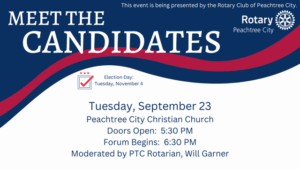When you get together with 21 elected officials from 10 different metro Atlanta counties, there are bound to be some disagreements here and there.
This “regional roundtable” group will be selecting transportation projects for potential funding by a voter-approved regional sales tax. But the roundtable has a ways to go before they can even get started.
The first major stumbling block for the roundtable, which includes two Fayette representatives, is how it will elect a five-member executive committee which by law will put together the first draft of a proposed project list for the entire 10-county region.
While the executive committee is charged with creating a draft list of projects for funding under a potential regional sales tax, the full roundtable also has the power to add or remove certain projects from that list with a majority vote.
One proposal is for a majority vote of the full roundtable. While that seems simple enough, it left worries that smaller counties like Fayette could be under-represented by the larger more populous counties like Fulton and DeKalb.
Another proposal would break the 10 counties up into five pairs, with each pairing selecting one person to represent them on the roundtable. It was proposed for Fayette to be paired with Douglas County.
A third concept would have had the full roundtable picking two executive committee members, and three groups of counties picking one each. Under that proposal Fayette would have been working with Douglas, Clayton and Henry counties.
Yet another suggestion was for the roundtable to be split into two groups: the five largest counties and the five smallest counties based on population. Each would elect two executive committee members, and the full roundtable would vote on the fifth and final executive committee member.
As one might imagine, there was a significant amount of squabbling at the first roundtable meeting over which process to choose.
Fulton County Commission Chairman John Eaves noted that he and his counterpart in DeKalb County agree that since their two counties account for roughly 40 percent of the population of the region, “to restrict our representation as one person on the executive committee, 20 percent, is an inherent unfairness not only in terms of population but also in terms of the revenue generated from our jurisdictions.”
Fayetteville Mayor Ken Steele argued that the project list should be developed based on “an equitable distribution of projects.” To do that, the roundtable should make sure that the smaller counties in Atlanta are well-represented on the five-member executive committee, Steele said.
“If you make up 40 percent of the population … you should get 40 some percent of the capital projects in your area” to address transportation projects in each county, Steele said. At the same time, the larger counties in metro Atlanta need to “recognize how important the smaller counties are,” he added.
“I frankly feel the smaller counties would give us greater representation,” Steele said of the roundtable’s eventual five-member executive committee.
Eaves said he didn’t think the roundtable should vote on the matter so more time could be allowed for alternate proposals for executive committee member selection.
Steele noted that roundtable members hashed out the caucus proposals and shared other concerns during conference calls since last month’s roundtable meeting.
“We had three conference calls, and all of this was discussed to bring us to this point today. And here we are today, some of us who didn’t avail ourselves of the conference calls want us to delay,” Steele said. “I think that’s indicative of do we have the commitment … to attend to the responsibilities.”
Fayette’s other roundtable representative, County Commission Chairman Jack Smith, also argued for a caucus selection process to be used.
“A caucus creates a very balanced situation,” Smith said. “I think a caucus idea is probably fairest to insure we have corresponding representation across the whole region. I think that is critical to advancing the bill through the voter stage.”
Although a majority of the roundtable voted to use a caucus selection method instead of a majority selection method, no specific methodology was adopted. Instead, the matter was tabled to allow staff from the Atlanta Regional Commission to propose some alternatives, and it was also suggested that several more conference calls would be necessary to settle the matter going into the roundtable’s Dec. 17 meeting.
The most crucial goal of that December meeting, however, will be a vote on the criteria by which the regional transportation projects will be selected by the roundtable.
A draft list of criteria offered by state Transportation Director Todd Long was discussed briefly at Thursday’s roundtable meeting.
Among the proposed criteria is for all new road projects to be aimed at “trips to/from and within major employment and activity centers throughout the region.” Also, such projects should focus on improving “the most congested regional corridors.”
This may bode well for one Fayette project that actually exists in Fulton County: the improvement of the interchange of Ga. Highway 74 at Interstate 85.
It does not, however, look good for cart path projects in Peachtree City, for example, as the recommended criteria for bike and pedestrian projects to be funded must provide connectivity to and from a major regional employment center, activity center or planned transit.
The criteria, however, will not apply to the 15 percent of the sales tax revenues which would be redistributed to each county and city for use on any local transportation project it wishes. So, for example, the Peachtree City Council like other Fayette local governments, would determine how that money is spent regardless of the criteria for regional transportation projects.
That means if Peachtree City wants to allocate its funds toward golf cart path projects, it can do so.
The 15 percent funds will be distributed based on a formula comparing each city and county to the remainder of the region in terms of population, which counts for 20 percent of the formula, and in total road lane miles (both paved and unpaved), which counts for the remaining 80 percent of the formula.











Leave a Comment
You must be logged in to post a comment.